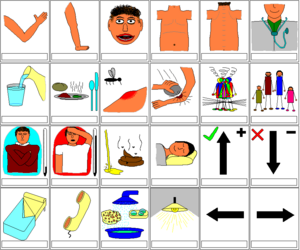Nonverbal communication facts for kids

Nonverbal communication is how we send messages without using words. This includes things like how we look at someone (eye contact), our body language, how close we stand to others (social distance), and even our voice's tone. When we talk, our body and voice also send signals. Other people then understand these signals.
The idea of studying nonverbal communication began in 1872. Charles Darwin noticed that animals like lions and dogs also used gestures and expressions to communicate. He wrote a book about it. Today, many experts believe nonverbal communication can tell us more than words alone.
Our voice has nonverbal parts too, like its quality, speed, and how loud it is. These are called paralanguage. Things like your tone, how you emphasize words, and other vocal sounds add meaning. Most studies of nonverbal communication look at how people interact. They focus on the place where communication happens, how people look, and what they do during a conversation.
Nonverbal communication involves sending and understanding messages. Encoding is when we show emotions so others can understand them. Decoding is our ability to correctly understand these emotions. When we encode, we use signals like facial expressions or gestures. We might think these signals are the same everywhere. But Culture plays a big part in how we use and understand nonverbal cues. For example, in many Indigenous American communities, silence and subtle nonverbal cues are very important for understanding messages.
Contents
Why Nonverbal Communication Matters

Some experts say that nonverbal communication makes up most of what we communicate. It can send messages through your voice and your body signals. Body signals include how you look, your conscious and unconscious movements, and how you use personal space. If your body language doesn't match your words, it can send the wrong message. Ignoring nonverbal cues means you might miss a lot of what someone is trying to say.
Nonverbal communication helps create a strong first impression. This is important when meeting new people or going for an interview. People often form an opinion about you in the first few seconds. When someone meets you, they use all their senses. Most of what they notice comes from sight (83%) and hearing (11%).
Many indigenous cultures teach children using nonverbal communication. Kids learn by watching and joining in. Nonverbal cues are key to this observation-based learning.
Experts like Judee K. Burgoon say nonverbal communication is important for several reasons:
- It's everywhere. Nonverbal cues are part of every conversation. Your body, face, voice, looks, touch, distance, and timing all play a role. Even written messages can have nonverbal parts. Emails and social media use emojis, bold text, or pictures to add nonverbal meaning.
- It does many things. We use many nonverbal signals at once. This lets us send and receive several messages at the same time.
- It can be a universal language. Smiling, crying, pointing, and glaring are understood by people from different countries. These signals help us communicate when we don't speak the same language.
How We Use Nonverbal Cues
Nonverbal communication includes many signals beyond spoken words. These are gestures, facial expressions, body language, and vocal sounds like tone. These cues carry subtle meanings that are key to good communication. For example, facial expressions show emotions powerfully. Sometimes, tiny, quick movements called microexpressions reveal true feelings. These happen very fast and show what a person really feels, even if they try to hide it.
Some nonverbal cues are understood everywhere. But others mean different things in different cultures. So, it's important to understand these differences to avoid misunderstandings. Knowing the tone of voice, how loud someone speaks, and what touch means in different cultures helps us understand better. It's also important to know that cultures have "display rules" for emotions. This means what is okay to show. Being culturally sensitive helps us interpret nonverbal cues correctly.
Understanding how words and nonverbal cues work together helps us grasp what people mean. If words and body language don't match, it can be confusing. In cultures where nonverbal cues are very important, this mismatch causes problems. In cultures that focus on clear words, it's essential for words and nonverbal cues to align.
Learning to understand nonverbal signals helps us connect with people from different backgrounds. It helps us understand human behavior and build meaningful relationships. Both verbal and nonverbal communication are connected and important.
First Impressions
It takes only a tenth of a second for someone to form a first impression of you. A study from Princeton University found that this short time is enough to judge things like how attractive, likable, trustworthy, or capable a person seems. Your first impression is a lasting nonverbal message. How you present yourself tells a lot to others. This includes your clothes, facial expressions, and overall look.
Sometimes, negative first impressions can come from how someone looks or from personal biases. But often, first impressions can be quite accurate. In some cultures, like those that value group harmony, it can be harder to change a first impression. This is because they focus more on the overall situation and group agreement.
Body Posture
Posture is a nonverbal cue that shows how you position your body. It gives information about a person's character, feelings, and attitudes. Different postures include slouching, standing tall, or crossing your arms. Your body stance sends various messages, good or bad. For example, studies have found many postures linked to discomfort or hiding information.
Posture can show how much attention or interest someone has. It can also show the difference in status between people. An "open" body posture often means a person likes the other person. Leaning forward can also show positive feelings. People often change their posture depending on the situation. For instance, you might relax your posture in a safe situation. But your body might tighten up when you are stressed.
Clothing and Appearance
Clothing is a very common way we communicate without words. The study of clothing and objects as nonverbal communication is called artifactics. The clothes you wear send nonverbal messages about your personality, background, and financial status. They also influence how others react to you. Your clothing style can show your culture, mood, confidence, interests, age, and beliefs. For example, Jewish men wear a yarmulke to show their religious belief. Scottish men wear kilts at traditional events to show their culture.
Besides beliefs and nationality, clothing can attract others. People might wear accessories and fancy clothes to attract partners. Clothing can be a way to express yourself, showing off your power, wealth, or creativity.
What you wear also says a lot about your personality. A study found that women who dressed for comfort were often more self-controlled and dependable. Women who didn't like to stand out usually had more traditional views. Clothing, though nonverbal, tells people about your personality. How you dress often comes from deeper feelings, experiences, and culture. It shows who you are or who you want to be that day. It also shows who you want to be associated with. Clothing can even start relationships by giving clues about the wearer.
In some groups, like gangs, clothing is a strong nonverbal signal. Gang members often wear specific colors to show their neighborhood. Hats, bandanas, and oversized pants can also be used as identifiers. Group colors and clothing often show who you belong to.
Gestures and Facial Expressions
Gestures are movements made with hands, arms, or the body. They also include head, face, and eye movements, like winking or nodding. Some gestures are called emblems. These are common, culture-specific gestures that can replace words. For example, a hand wave in Western cultures means "hello" or "goodbye." But a single gesture can mean very different things in different cultures. It can be polite or very offensive. However, some gestures, like a shoulder shrug, are understood almost everywhere.
Gestures can be either speech independent or speech related. Speech-independent gestures have a direct verbal meaning that is understood in a specific culture. A wave or a peace sign are examples. Speech-related gestures are used with words. They help emphasize the message. For example, pointing to an object while talking about it.
Facial expressions are a very practical way to communicate. With all the muscles in our face, we can make over ten thousand different expressions. This makes facial nonverbal cues very clear and honest, unless someone tries to fake them. Many emotions, like happiness, sadness, anger, and fear, are understood all over the world.
Emotions are shown in two ways: negative and positive. Negative emotions often cause muscles to tighten. For example, a furrowed forehead or squinting eyes. Positive emotions show up as relaxed muscles around the mouth and wider eyes. When people are truly relaxed, they might tilt their head, showing their neck. This is a sign of high comfort.
Gestures can be divided into three groups:
Adapters
Some hand movements are not really gestures. They are things people do with themselves or objects, like scratching, fidgeting, or tapping. These behaviors can show that someone is anxious or uncomfortable. This often happens when a person isn't in control of the conversation. These movements are called adapters. They might not seem related to what is being said. But they can show how the speaker feels (nervous, bored). These movements are believed to show a person's hidden thoughts or feelings.
Symbolic Gestures
Other hand movements are specific, meaningful gestures called symbolic gestures. They are the opposite of adapters. Their meanings are meant to be understood. They have a clear meaning for both the sender and receiver. Common symbolic gestures include a "raised fist" or "thumbs up." Unlike adapters, symbolic gestures are used on purpose to communicate. Sign languages are complex systems of symbolic gestures. Some educators use sign language and lip-reading to help deaf learners. Every culture has its own unique gestures. Very similar gestures can have different meanings across cultures. Symbolic gestures are usually used without speech, but can also go with speech.
Conversational Gestures
Conversational gestures are in between adapters and symbolic gestures. These hand movements go along with speech. They are related to what is being said. Conversational gestures are only made by the person who is speaking.
There are a few types of conversational gestures. Motor movements are rhythmic and repetitive. They don't always need words because their meaning is simple. The speaker's hand often stays in one position. When used with words, they can emphasize certain syllables. For example, pointing and saying, "That way." Lexical movements are more complex. They are not rhythmic or repetitive. They are longer and more varied. An example is giving detailed directions with many hand movements to show turns.
Distance and Space

The amount of space we keep between ourselves and others is called Proxemics. This shows how we feel about others at that moment. Edward T. Hall defined four main distance zones in American culture:
- Intimate distance: Touching to 18 inches (0–46 cm). This is for close relationships and shows trust.
- Personal distance: 18 inches to 4 feet (0.46–1.22 meters). This is comfortable for most everyday interactions.
- Social distance: 4 to 12 feet (1.22–3.66 meters). This is used for business or classroom communication.
- Public distance: More than 12 feet (3.66 meters). This is for situations where two-way talk isn't expected, like speeches.
Intimate space is for people who feel very comfortable with each other, like family or close friends. Personal space is for friends. Social distance is common for talking with classmates or strangers. Public distance is for large groups, like lectures.
Eye Contact
Eye contact is when two people look into each other's eyes at the same time. It's the main nonverbal way to show you are engaged, interested, and paying attention. People use their eyes to show interest, like winking or eyebrow movements. If someone makes little or no eye contact, it often shows disinterest. When someone is interested, their pupils might get bigger.
The length of eye contact is very important. Generally, the longer two people make eye contact, the closer their relationship. Gaze includes looking while talking and listening. How long someone gazes, how often they glance, and how their pupils change are all important nonverbal cues. Liking someone often increases with more mutual gazing.
Eye contact can also show if someone is being dishonest. Some experts say that when people lie, their eyes might blink more. However, liars don't always avoid eye contact. Sometimes, they make more eye contact to seem more believable. But there are many nonverbal cues that can reveal hidden knowledge or true opinions. These can include body movements and changes in voice. It's important to remember that cultural background affects how deception is detected.
Vocalics (Voice Cues)
Nonverbal communication includes parts of speech that aren't words. Prosody, especially vocalics, is very important. This includes things like tempo (speed), volume, inflection (changes in pitch), pauses, and pitch. These can show emotion and attitude without using specific words. Vocalics also includes sounds with specific meanings, like saying “brrr” when you're cold. These are not words, but they add to the message. These sounds often come with other nonverbal cues.
Babies rely a lot on nonverbal vocalics to show what they need. As caregivers talk to babies, the babies learn to pick up and copy intonation. As they grow, babies learn to develop their own voices and vocalics.
Studies show that changing the vocalics of a speech can change how much people like the speaker. When a speaker sounded more conversational instead of forceful, they were seen as more trustworthy. Vocalics can greatly influence communication through its many different cues.
Nonverbal Communication Across Cultures
Overview
Nonverbal communication has very precise and symbolic meanings, similar to spoken language. But these meanings are shown through gestures, body posture, and timing. Nonverbal cues differ greatly across cultures. These differences can cause misunderstandings, even when people don't mean to offend. Differences can be in how people prefer to communicate. For example, Chinese people often prefer silence over talking. Differences can also be in how cultures see time. Chronemics is how people handle time. It can be polychronic, meaning people do many things at once (common in Italy and Spain). Or it can be monochronic, meaning people do one thing at a time (common in America).
Because nonverbal communication varies in many ways—gestures, gaze, clothing, posture, or even environmental cues—there's a lot of room for cultural differences. In Japan, workers use wide arm gestures to give clear directions, along with bows to show respect. One main factor that makes nonverbal communication different across cultures is whether they are high-context or low-context. High-context cultures rely mostly on nonverbal cues and gestures. They use close relationships, social rules, and shared beliefs. Low-context cultures depend mostly on words and direct verbal communication. Social rules are less strict in these cultures.
Gestures Across Cultures
Gestures vary widely in how they are used and what they mean across cultures. A common example is pointing. In the United States, pointing with one finger is common. But in some cultures, it's considered rude. People from Asian cultures often use their whole hand to point. Another example is sticking out your tongue. In Western countries, it can be seen as mockery. But in Polynesia, it's a greeting and a sign of respect. Clapping is used for applause in North America. But in Spain, it's used to call a waiter.
Nodding and shaking the head also differ. Northern Europeans nod up and down for "yes" and shake side to side for "no." But Greeks have used an upward nod for "no" and a downward nod for "yes" for thousands of years. There are many ways to wave goodbye. Americans wave with the palm outward. Italians wave with the palm inward, moving fingers toward the other person. French and Germans wave with the hand horizontal, moving fingers toward the person leaving. Also, gestures are often used in informal settings and more by children.
The "OK" hand gesture is common in the United States to show permission. In Japan, the same sign means "money." In other cultures (like Argentina, Belgium, France, and Portugal), it means "zero" or "nothing." In some cultures, holding up the index and middle fingers with the palm outward can be insulting. In others, it simply means the number "two" or the "V for Victory" sign. The same sign with the palm inward means "peace" in some cultures.
Speech-Independent Gestures
Speech-independent gestures are nonverbal cues that mean a specific word or expression. They are like a dictionary definition. Even though nonverbal gestures differ across cultures, speech-independent gestures must be understood by everyone in that culture. Unlike most gestures that help clarify speech, speech-independent gestures don't need words to be understood. They usually involve a single movement.
Many speech-independent gestures are made with the hand. The "ring" gesture (thumb and index finger forming a circle) often means "okay." Some can be done with the face. For example, a wrinkled nose might universally mean disapproval or disgust. Nodding your head up and down or side to side shows understanding or lack of it. Even though speech-independent gestures don't need words, they still need context. Using your middle finger can be funny or rude. You need to look at other behaviors and who is speaking to understand its meaning.
How Emotions Are Shown
Emotions are a key part of nonverbal communication. Just like gestures, how people show their emotions varies across cultures. For example, in Arab and Iranian cultures, people show grief openly and loudly. But in Asian cultures, it's often seen as wrong to show emotion openly. For people in Western countries, laughter means amusement. But in some parts of Africa, it can mean wonder or embarrassment.
Emotional expression changes with culture. Native Americans tend to be more reserved and show less emotion. Frequent touching is common for Chinese people. However, actions like touching, patting, hugging, or kissing are less common and often not done in public in America. Winking also has different meanings. In Latin culture, a wink can be a romantic invitation. In Yoruba (Nigeria), children are taught that a wink means it's time to leave the room. To the Chinese, it's an offensive gesture.
Nonverbal Actions and Distance
Nonverbal actions should match the message being sent. If they don't, it can cause confusion. For example, someone wouldn't usually smile and gesture widely when saying something sad. It's very important to be aware of nonverbal communication, especially when comparing gestures, gaze, and tone of voice across cultures. Latin American cultures often use big speech gestures. Middle Eastern cultures are usually more modest in public and less expressive.
Rules about staring or gazing also differ. In some cultures, gaze can show respect. In Western culture, eye contact means attentiveness and honesty. But in Hispanic, Asian, Middle Eastern, and Native American cultures, eye contact can be seen as disrespectful or rude. Lack of eye contact doesn't mean someone isn't paying attention. Voice tone also changes across cultures. Depending on whether a culture is expressive or not, different voice variations can show different reactions.
The acceptable physical distance between people is another big difference. In Latin America and the Middle East, people stand much closer than most Europeans and Americans are comfortable with. This can lead to misunderstandings. An American might feel their personal space is invaded, while the other person might wonder why the American is standing so far away. Generally, for cultures that prefer close distances, 1 foot (30 cm) is for lovers, 1.5–4 feet (45–120 cm) is for family and friends, and 4–12 feet (1.2–3.6 meters) is for strangers. In contrast, most Native Americans value more distance to protect themselves.
Learning in Indigenous American Communities
Nonverbal communication is often used to help children learn in indigenous American communities. It's key for working together in shared activities. Children learn how to interact using nonverbal cues by carefully watching adults. Nonverbal communication allows for constant observation. It also signals to the learner when it's time to join in. Culture plays a big role in how learning activities are set up. In many Indigenous American Communities, nonverbal communication is a valued way for children to learn. For example, a study found that Mexican-heritage children were more likely to describe children working together without speaking as "talking with their hands and with their eyes."
A main feature of this nonverbal learning is that children can observe and take part in all parts of an activity. Many Indigenous American children are often close to adults and other children doing tasks they will eventually learn. Objects and materials become familiar as activities are part of daily life. Learning happens in a very real-life setting, not one made just for teaching. For example, Mazahua children learn how to run a market stall by watching and cooperating. They learn basic responsibilities through non-structured activities. This way of learning teaches them to work together in groups to solve problems. It shows that taking part in everyday interactions helps children learn their culture through nonverbal social experiences.
In some Indigenous communities, children say they work at home to build family unity. This is similar to how they want to build unity in their communities. Most indigenous children learn the importance of this work through nonverbal communication. For example, children are guided to fold a paper figure by watching the posture and gaze of those teaching them. This applies to homes and communities. Children wait for cues from others to start cooperating.
One important part of nonverbal communication in these communities is "context-embeddedness." This means children are deeply involved in community activities, both physically and in relationships. This helps promote nonverbal communication because words aren't always needed. When children are active participants in an activity, they share a common understanding. This helps nonverbal communication to happen and be maintained. This idea of "context-embeddedness" allows nonverbal communication to be a way of learning in Native American communities like Alaskan Athabaskans and Cherokee. By observing family and community interactions, social engagement is mostly nonverbal. For example, when children speak to elders, they are expected to speak carefully. This shows respect. Too much talking when the conversation changes can seem weak or disrespectful. This careful self-control shows how traditional social interaction in these cultures relies on nonverbal communication.
Children in the Warm Springs Indian Reservation community use nonverbal cues in their school learning. This includes using hand gestures from Native American religion in everyday talk. They also show emotional self-control and move their lower face less to focus attention on their eyes during face-to-face talks. So, their approach to social situations in a classroom might make it harder in a mostly verbal learning environment. Most Warm Springs children learn best from a model that uses nonverbal communication, collaboration, traditional gestures, observational learning, and shared understanding.
It's important to note that while nonverbal communication is more common in Indigenous American Communities, verbal communication is also used. Verbal communication doesn't replace taking part in an activity. Instead, it acts as extra guidance or support.
Challenges of Only Using Words Across Cultures
A lot of human communication is nonverbal. So, learning a language without understanding its nonverbal rules can lead to misunderstandings. This can cause conflicts and confusion, even if someone speaks the language fluently. Nonverbal communication can bring cultures together or push them apart. From birth, children learn the gestures and cues their culture uses. But some movements are universal. For example, humans all smile when happy and frown when upset.
How Time Communicates (Chronemics)
Chronemics is the study of how time is used. Our use of time can send nonverbal messages. How we use time and whether we give our time to others can communicate different things. Chronemics can show what we value and also who has power. For example, if you visit someone powerful, like your boss, you might be kept waiting. But it would be rude to make a powerful person wait for you. This shows that the time of powerful people is seen as more valuable.
Movement and Body Position
Kinesics: Body Movement
Kinesics is the study of our movements, especially those involving our hands, body, and face. The term was created by Ray Birdwhistell, who thought "body language" wasn't quite right. He explained it as nonverbal behaviors that come from body movement. For example, someone smiling and leaning forward, while making eye contact, might seem friendly and approachable. In contrast, someone leaning back with a serious face and little eye contact might seem unfriendly or dominant.
More research shows that eye contact is a key part of kinesics. Good eye contact gives a person credibility. People who don't make eye contact might be seen as untrustworthy. More eye contact was also linked to being more likable and believable. For example, in a study, service workers who smiled seemed warmer than those who didn't. Customers said that workers without smiles or open body movements (like waving) seemed less friendly.
Haptics: The Power of Touch

Haptics is the study of touching as nonverbal communication. It looks at how people and animals communicate through touch.
Touches among humans that communicate include handshakes, holding hands, kissing, back slapping, high fives, and a pat on the shoulder. Touching oneself, like scratching, can also send messages. These behaviors are called "adapters" and can show a person's intentions or feelings. The meaning of touch depends a lot on the culture, the situation, the relationship between people, and how the touch is done.
Touch is a very important sense for humans. Besides giving information about surfaces, it's a key part of nonverbal communication in relationships. It's vital for showing physical closeness. Touch is the first sense to develop in a fetus. Human babies have a hard time surviving without a sense of touch, even if they can see and hear.
Touching is seen differently in different countries. What's okay varies from one culture to another. For example, in Thai culture, touching someone's head can be rude. Studies have shown that touching was rare among English, French, and Dutch people, compared to Italians and Greeks.
See also
 In Spanish: Comunicación no verbal para niños
In Spanish: Comunicación no verbal para niños
- Animal communication
- Augmentative and alternative communication
- Behavioral communication
- Chinese number gestures
- Intercultural competence
- Microexpression
- Observational learning
- People skills
- Semiotics
- Unconscious communication



